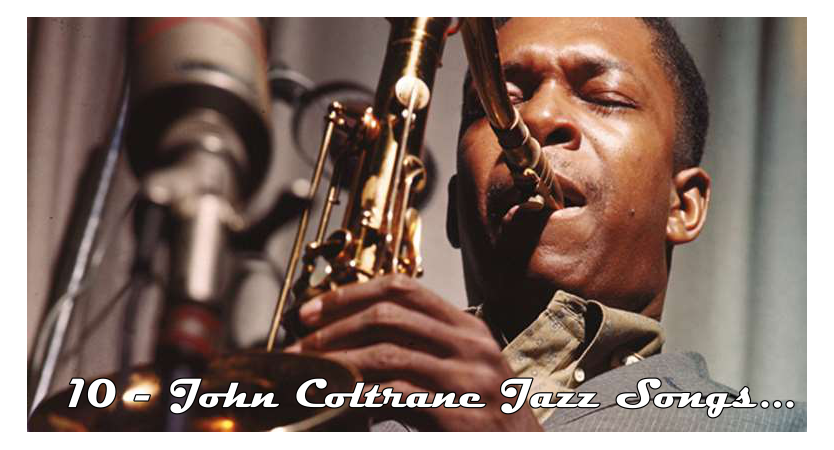(ThyBlackMan.com) John Coltrane, one of the most influential jazz musicians of all time, revolutionized the genre with his innovative techniques, spiritual depth, and breathtaking improvisation. His music serves as both a bridge between the past and future of jazz and a reflection of the Black experience in America. Coltrane’s work is not only a masterclass in jazz composition and performance but also a testament to the resilience, creativity, and spiritual pursuit of Black artists. Below are ten essential John Coltrane songs that one must listen to, each offering a glimpse into his genius and its relation to Black history.

1. A Love Supreme, Pt. 1: Acknowledgement (1965)
Why It’s a Must-Listen: “A Love Supreme” is arguably Coltrane’s magnum opus. The first movement, “Acknowledgement,” is a deeply spiritual piece that represents Coltrane’s devotion to God and his personal transformation. With its iconic four-note mantra, the composition is hypnotic and meditative, embodying the idea of divine enlightenment through jazz. This piece serves as an invocation, drawing the listener into a transcendent experience where music and spirituality become inseparable.
Beyond its musical depth, “A Love Supreme” is groundbreaking in its structure and execution. Coltrane’s use of modal jazz, free improvisation, and repetitive motifs gives the piece a chant-like quality, reinforcing its spiritual message. The interplay between the quartet members—McCoy Tyner’s lush piano chords, Jimmy Garrison’s steady bass lines, and Elvin Jones’s polyrhythmic drumming—creates an immersive and almost hypnotic soundscape that invites deep introspection.
Relation to Black History: Coltrane’s spiritual awakening in the 1960s paralleled the broader cultural awakening within the Black community, as the Civil Rights Movement sought justice and self-determination. The album resonated with those seeking higher consciousness and liberation.
2. My Favorite Things (1961)
Why It’s a Must-Listen: Coltrane reimagines this Rodgers and Hammerstein classic through the lens of modal jazz, replacing the lyrics with a soprano saxophone melody that feels both familiar and entirely new. His use of Eastern musical influences makes it an early example of world jazz. The song’s waltzing rhythm and repetitive phrasing create a hypnotic, almost trance-like atmosphere that allows for deep improvisational exploration.
One of the most striking elements of this piece is Coltrane’s use of the soprano saxophone, which gives the song a bright, airy quality. Unlike his usual tenor saxophone work, this instrument adds a unique texture, making the song feel simultaneously playful and meditative. The composition’s cyclic structure allows Coltrane and his bandmates to explore variations in tone and dynamics, keeping the listener engaged from start to finish.
Relation to Black History: During the early 1960s, jazz was transitioning into a form of self-expression that connected with broader cultural movements. Coltrane’s ability to transform a Broadway tune into a powerful jazz statement symbolized the reclaiming of cultural narratives by Black artists.
3. Giant Steps (1960)
Why It’s a Must-Listen: “Giant Steps” is famous for its complex chord progressions, now known as “Coltrane Changes.” The piece is a technical marvel, often seen as a rite of passage for jazz musicians. The rapid harmonic shifts challenge improvisers to think ahead, pushing the boundaries of traditional bebop structures. Each phrase carries an intensity that showcases Coltrane’s virtuosity and innovation, leaving little room for hesitation.
The track’s fast-paced, almost relentless energy gives it an urgent, exploratory feel. Coltrane’s saxophone lines navigate the harmonic twists with a sense of fearless curiosity, embodying the spirit of pushing forward despite challenges. This energy mirrors the ambition and perseverance needed in both music and life, making “Giant Steps” an essential listen for those who appreciate jazz’s technical brilliance.
Relation to Black History: The song’s rapid changes and innovations mirror the rapid progress of the Civil Rights Movement. It exemplifies the ambition and forward momentum of Black artists striving for excellence against societal constraints.
4. Naima (1959)
Why It’s a Must-Listen: Named after Coltrane’s first wife, “Naima” is a ballad of unparalleled beauty, featuring delicate phrasing and an ethereal atmosphere. It showcases Coltrane’s emotional depth. Unlike his high-energy compositions, “Naima” is introspective, utilizing space and sustained notes to create a deeply moving experience. The melody unfolds gently, allowing each note to resonate fully before transitioning to the next.
The song’s harmonic simplicity belies its emotional complexity. Coltrane’s phrasing is both tender and expressive, conveying a profound sense of love and longing. The lush accompaniment by the rhythm section adds to the song’s dreamy quality, making it a timeless standard in jazz balladry.
Relation to Black History: Black love and familial ties have always been foundational to cultural resilience. “Naima” honors these bonds through a deeply personal composition that transcends time and genre.
5. Equinox (1960)
Why It’s a Must-Listen: Rooted in the blues, “Equinox” is a dark and brooding piece that showcases Coltrane’s ability to merge traditional African American music with modern jazz techniques. The composition’s heavy, swinging groove creates an almost hypnotic effect, drawing listeners into a meditative state. Coltrane’s deep, resonant tone further emphasizes the song’s bluesy, introspective nature.
Relation to Black History: Blues music has deep roots in Black history, symbolizing both struggle and resilience. “Equinox” pays homage to the legacy of African American music while pushing its boundaries through modern jazz elements.
6. Afro Blue (1963)
Why It’s a Must-Listen: This song highlights Coltrane’s ability to blend African rhythms with jazz. The shifting time signatures and passionate saxophone solos make it an unforgettable listening experience. His interpretation brings a new level of intensity and complexity, pushing the boundaries of jazz and connecting it to its African roots.
Coltrane’s ability to take an Afro-Cuban composition and infuse it with modal jazz techniques speaks to his mastery of musical fusion. His improvisational flights on this track are breathtaking, transforming the original melody into something ethereal and profoundly moving.
Relation to Black History:
“Afro Blue” acknowledges the African rhythmic traditions that heavily influenced jazz. It serves as a bridge between African musical heritage and contemporary jazz, celebrating Black cultural continuity and evolution.
7. Alabama (1963)
Why It’s a Must-Listen: A powerful response to the 1963 bombing of a church in Birmingham, Alabama, this piece embodies sorrow and hope through its hauntingly slow and deliberate phrasing. Coltrane took inspiration from a speech by Dr. Martin Luther King Jr., incorporating its cadences into his saxophone performance.
The composition is deeply emotional, building slowly with a sense of mourning and reflection before evolving into a determined call for resilience. Coltrane’s measured delivery mirrors the somber reality of racial violence while also providing an outlet for healing.
Relation to Black History:
“Alabama” is a direct musical tribute to the Civil Rights Movement. It stands as a historical document of resistance, reflecting the pain of racial injustice while conveying a sense of dignity and resolve.
8. Impressions (1963)
Why It’s a Must-Listen: This modal jazz masterpiece is driven by a relentless groove, showcasing Coltrane’s ability to extend musical ideas through deep, sustained improvisation. The track carries an intense energy, reflecting the rapid societal changes of the time.
The extended soloing on “Impressions” is an example of Coltrane’s “sheets of sound” technique, where rapid, cascading notes create an overwhelming sonic experience. His improvisations explore every nuance of the scale, demonstrating his commitment to pushing jazz into new, uncharted territories.
Relation to Black History:
“Impressions” mirrors the urgency of the Civil Rights Movement, symbolizing the push for change and the continuous struggle for equality. It captures the feeling of movement and progress that defined the era.
9. Crescent (1964)
Why It’s a Must-Listen: A deeply introspective composition, “Crescent” captures Coltrane’s evolving spiritual and artistic journey, marked by an emotional and dynamic saxophone performance. It is somber yet hopeful, reflecting his search for deeper meaning through music.
Coltrane’s phrasing on this track is both tender and powerful, shifting seamlessly between moments of contemplation and catharsis. The song’s structure showcases his ability to tell a story through instrumental expression.
Relation to Black History:
“Crescent” represents the transition from struggle to enlightenment, paralleling the Black community’s perseverance and cultural evolution. It embodies the hope for a brighter future while acknowledging the challenges of the past.
10. Blue Train (1957)
Why It’s a Must-Listen: A quintessential hard-bop recording, “Blue Train” is an essential listen, blending blues influences with complex jazz harmonies and delivering one of Coltrane’s most memorable performances. The driving rhythm section and bold horn arrangements create a vibrant and powerful musical landscape.
This track is often considered one of Coltrane’s defining moments as a bandleader. His extended solo on “Blue Train” is filled with emotion, effortlessly blending technical precision with raw feeling.
Relation to Black History:
“Blue Train” reflects the power of Black artistic expression during the late 1950s. It represents a period when jazz musicians were reclaiming their creative independence and using music as a tool for cultural and personal storytelling.
John Coltrane’s music is more than jazz—it is an expression of Black history, spirituality, and resilience. His compositions continue to inspire musicians and activists alike, proving that jazz is not just a genre but a powerful force for social and artistic change. Each of these songs provides a glimpse into his evolution as an artist and his impact on both jazz and the Black experience in America. To understand Coltrane is to understand the history and future of jazz itself.

















Add the explanatory factors in this article to any university level undergraduate, or graduate class in ethno-musicology. Coltrane’s jazz is yet another African American linguistic that is suitable for usage in multidimensional space plus the axis of time. Coltrane’s music establishes, legitimizes, and give respect to a timeless jazz language that can only be referred to as ” something else ” .